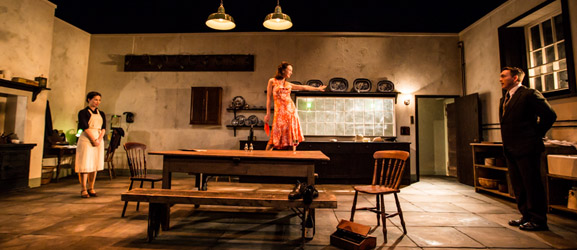After Miss Julie’s opening night at The MAC saw the cast perform to a sell-out audience – something which acclaimed director Emma Jordan must be getting used to following the successes of Scorch and Educating Rita. Based on Strindberg’s classic Miss Julie, After Miss Julie is a re-imagining of Patrick Marber’s adaptation of the original. Marber worked closely with Prime Cut Productions to transpose the action onto an Irish background; from an English Manor during celebrations for the Labour Party victory in 1945, Miss Julie’s estate is relocated to a Manor House in Fermanagh, during the festivities on VE Day.
The action takes place on one set; the servants kitchen of the manor house. We’re firstly introduced to the betrothed John and Christine, who hold the roles of chauffeur and house cook respectively. The set is beautifully designed, nostalgic and completely authentic, right down to the running taps and AGA stove. Both sound and lighting are used effectively to draw the audience into the scene, conveying the revellers outside celebrating the end of the war. As the revelry continues outside, inside the dramatic story of a love triangle crossing the social divide unfolds. Moral foundations, gender roles and class boundaries are all called into question as the lady of the house, Miss Julie, shares a lustful evening with John, and when John’s fiancée Christine realises what’s happened, reality comes crashing down around our protagonists.
Transposing the story onto the backdrop of a Fermanagh Manor House works well, and makes sense contextually. Whilst partition in the 1920s ensured the survival of estates such as Miss Julie’s, their southern counterparts were burnt out and destroyed during the War of Independence and the Civil War. A dramatic social and economic transformation of rural society would culminate in the late 1960s, with the end of Landlord-ism as the basis for rural economy and the collapse of the majority of landed families and their estates. Whilst families such as Miss Julie’s continued to figure head communities in a symbolic and structural way, they would inevitably lose their power with the emergence of the new politically aware middle class. Social mobility and the downfall of the landed aristocracy was, although not yet a reality, becoming increasingly more tangible.
Prime Cut Productions have put together a vastly experience cast for this adaptation, and their talent shines throughout the show. Ciaran McMeniman, as the deplorable John, continually flitting between kind and callous, and Pauline Hutton, as the ever dependable and realistic Christine, both deliver polished performances. However, the star of the night is undoubtedly Lisa Dwyer Hogg in the title role of Julie. Dwyer Hogg captures every emotion with ease; from hysteria to vulnerability, entitled superiority to naive idealism. Julie is portrayed sublimely and the audience are left truly identifying with her, regardless of her violent and unpredictable mood swings. Perhaps more than the other two characters, the sheer complexity of Miss Julie is conveyed effortlessly by Dwyer Hogg.
Thematically, After Miss Julie deals with some difficult subjects. Class boundaries and the idea of servitude regularly interacting with superiority is at the core of the play. John is perhaps most indicative of this; his attempts to educate himself are mocked by Julie. Julie’s father is only ever mentioned, yet as his possessions are scattered around the set, such as his shoes that John is supposed to be shining, he is omnipresent, as is his absolute authority over the house. Feminism is explored through the figure of Julie’s mother, a hard-line advocate for women’s rights. Gender conflict is considered through the power plays between John and Julie, as is sadism and masochism.
Despite having been adapted and re-imagined so many times, After Miss Julie still retains the visceral sentiments of Strindberg’s 1888 original; gasps of horror and shock were often heard from the audience. This naturalist tragedy is certainly not for the faint hearted, and perhaps it is best suited to theatre buffs and dedicated thespians going in with a background knowledge of the source material, as those being exposed to the plot for the first time may miss some of the nuances. Having said that, the excellent performances of the cast carry the audience through the exacting action, and thoroughly deserved the standing ovation they received.






